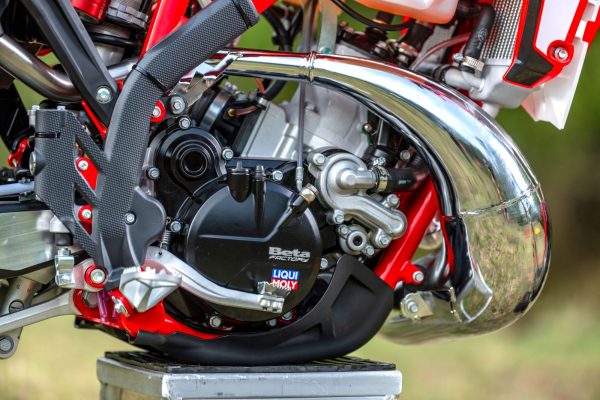The 2024 Beta RR 200 is the ultimate bike for those you guns keen to give trail riding or hard enduro a crack. Here's what we think of it.
The 2024 Beta RR 200 fits into the category of forgotten about capacities. For a long time many other manufactures, including KTM, produced a 200cc two-stroke but Beta is the only one left still making them. They all pulled out for a plethora of reasons including the lack of a class to race them in, but Beta saw the 200cc two-stroke as an excellent machine for those keen to dip their toe in the enduro market but didn’t want to hop on a bigger, more aggressive enduro bike.
The 2024 Beta RR 200 merges the agility of the lighter models (like the RR 125) with the enhanced torque characteristic of its more powerful counterparts, the RR 250 and RR 300. This model stands as a testament to Beta’s commitment to providing riders with a machine that is both nimble and robust, suitable for a broad range of off-road conditions, skill levels and even sizes.
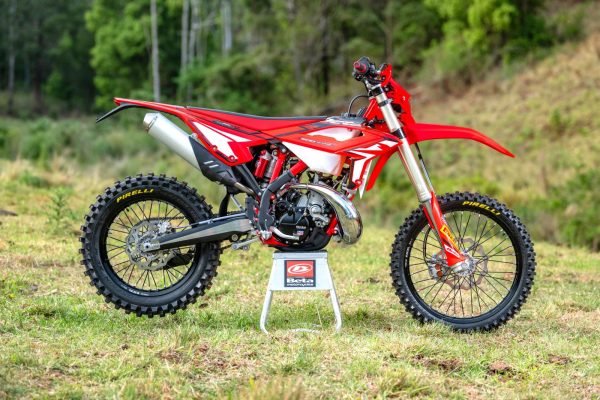
The 2024 Beta RR 200 is an off-road motorcycle that finds its niche between the lightweight manoeuvrability of the RR 125 model and the robust power of the larger RR 250 and RR 300 models. They’re the only manufacturer that carries four two-strokes in different capacities. It carries over the nimble chassis from the 125 but introduces added torque for bottom-end when you need it. This model maintains a weight similar to the 125 RR but benefits significantly from the increased torque, making it an interesting choice for riders looking for a balance between agility and power.
The 2024 Beta RR 200 is designed to bridge the gap between light agility and substantial power and for MY24 features a blend of advanced technology tailored with old-school two-stroke grunt.
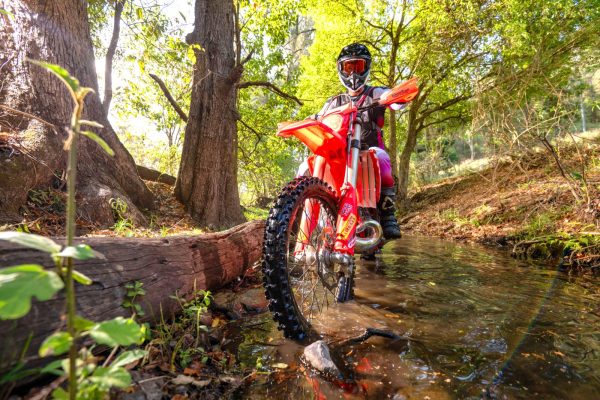
THE DNA
At the core of the RR 200 is a single-cylinder, two-stroke engine with a displacement of 190.2cc. It’s equipped with liquid cooling, a reed valve configuration for the intake, and a compression ratio of 13.5:1. The engine is paired with a six-speed manual transmission (yep, six-speed in a 200!) and the fuel system is the trusty old carburettor, specifically a 36mm Keihin carb but complemented by automatic oil injection. I think this is the best combination to date but I’ll come to that later on.
The frame of the RR 200 is constructed from Molybdenum steel with a double cradle split above the exhaust port. Suspension duties are managed by ZF components, with a 48mm fork setup at the front and a ZF monoshock at the rear. Both the front and rear suspension is adjustable, with preload, rebound and compression all capable of adjustment.
This model boasts a wheelbase of 1477mm and a ground clearance of 325 mm, a max length of 2167mm and a seat height of 930mm. While the seat height is the same as the bigger models it is actually not as long as the RR 250 and RR 300 but yields more ground clearance. It’s the same width and overall height but the shorter wheelbase makes it feel slightly smaller to sit on. The dry weight of the RR 200 is listed at 97kg, making it relatively lightweight and manoeuvrable. It has a fuel capacity of 9.5 litres too, ensuring a good range for longer rides and because it’s oil injected you don’t need keep mixing fuel!
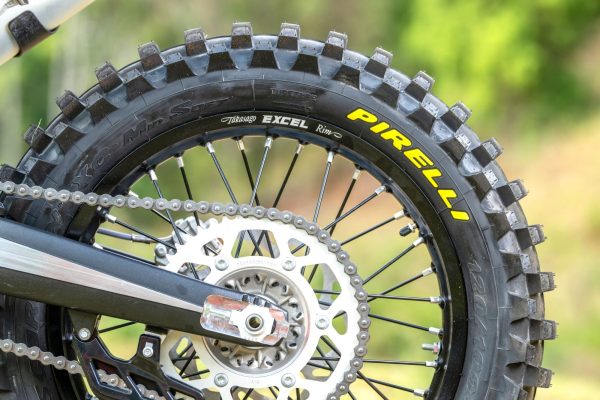
For stopping power, the RR 200 is equipped with Nissin hydraulic disc brakes on both the front and rear, with diameters of 260mm and 240mm, respectively. The bike rides on Maxxis Enduro tires, with the standard enduro setup of 21-inch front and an 18-inch rear.
It comes with standard digital instrumentation, including a clock, speedometer, trip odometer, and optional lap timer. The lighting system includes a standard halogen headlight which gives decent night vision.
The RR 200 features a new seat design with improved foam geometry and density. The suspension system benefits from lighter upper fork tubes for the MY24 models which are designed to make for “smoother damping and increased comfort” according to Beta. The front braking system has been upgraded for better durability under stress. Lastly, the bike showcases new graphics.
These specifications underline the 2024 Beta RR 200’s position as the middle child with a serious case of overachieving, combining the lightweight manoeuvrability of smaller bikes with the added torque and robustness of larger models. But how big is too big for a MY24 Beta RR 200?
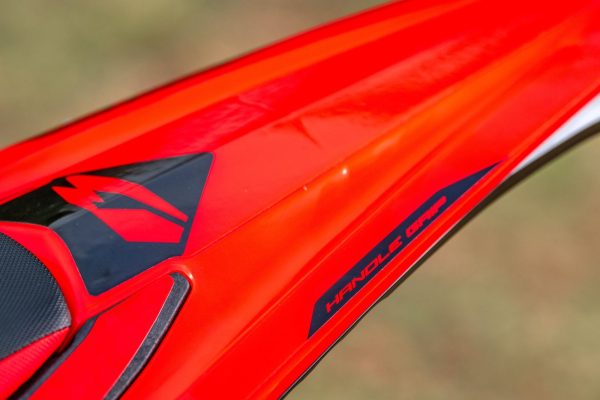
THE FIT
At 95kg and 188cm, I’m probably not the build Beta were imagining buying this bike but that also makes me perfect for testing the limit of the riders size on a Beta RR 200.
Jumping on the RR 200, it felt smaller than the more conventional 250cc and 300cc two-strokes. While it is only just shorter, the suspension is softer than the RR 250 and RR 300 meaning my weight compresses the rear-end so my static sag is lower than that of those models. This made it great for getting my feet on the ground but at my size, getting my feet on the ground isn’t really a problem. But it would be very handy for shorter riders or those that are nervous about not being able to stay upright.
The Beta RR 200 has a footrest height of 410mm which is higher than the RR300 which is 407mm and considering both models have the same seat height you’d expect the Beta RR 200 to feel more cramped and it does a little bit. While 3mm is nothing, the extra sag in the shock means the seat lowers even more when seated and my 188cm frame felt more cramped than it did on the RR 250 and RR 300. But anyone under 180cm will find the cockpit plenty roomy enough.
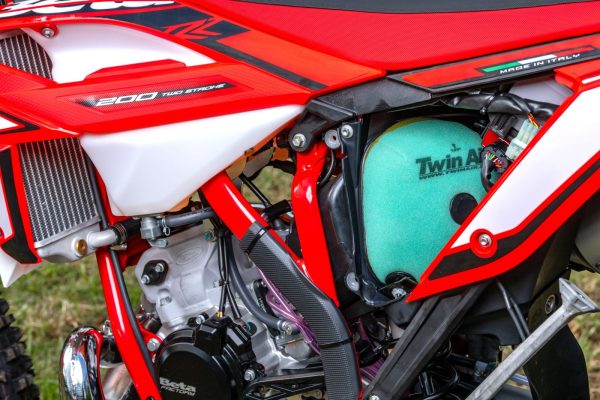
At 97kg (dry) the bike feels lightweight and that’s because it is. It’s lighter than any other model two-stroke enduro bike except for the 125s in every brand. Having less weight between my legs was awesome and even at my size, any weight saving is a bonus. It felt just as planted as the bigger models but afforded so much more flickability.
The motor is the real standout feature on his bike because it fights way out of its weight class. The RR 200 produces enough power and torque to lug my large arse up hills with ease in second or first gear. It really didn’t even require any more clutch work than the RR 250. I could crawl up a hill in second like I could on the RR 250 but when I reached the top and went to go full-throttle into the next corner it signed off earlier than the bigger models.
Beta have focused on moving the maximum amount of power the RR 200 can produce into the bottom-end which makes it so much easier to ride as you don’t have to keep revving it to keep it in the meat of the power, like you would a 125cc two-stroke. This is the kind of trait that suits a rider coming off a similar sized four-stroke trail bike and looking for something with much more capability but won’t hospitalise them or require them to have more skill than they can produce.
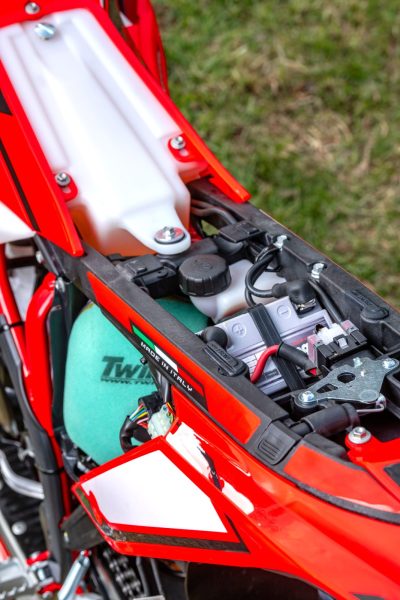
Think someone jumping off a Kawasaki KLX230 or a similar model 250cc four-stroke that wants a more agile bike with more grunt and racier suspension that they can jump off erosion mounds or smash into logs.
As for the suspension, the MY24 Beta RR 200 was never designed to be raced at full-speed by a pro and therefore the ZF gear doesn’t really shine there. But, for someone looking at getting into harder trailriding or someone who simply wants to go faster than they can on the KLX230, the ZF suspension is perfect. Anyone stepping up from a smaller or slower motorcycle will find the ZF suspension more than capable of anything they can throw at it.
While we have complained in the past about ZF suspension being too soft for going really fast into big bumps on bikes ridden by fast trailriders who are on the bigger side, that kind of person wouldn’t be in the market for a RR 200. The ZF suspension is incredible for riders in the 70-80kg mark and those that are hopping off a motorcycle with less edge than the Beta RR 200.
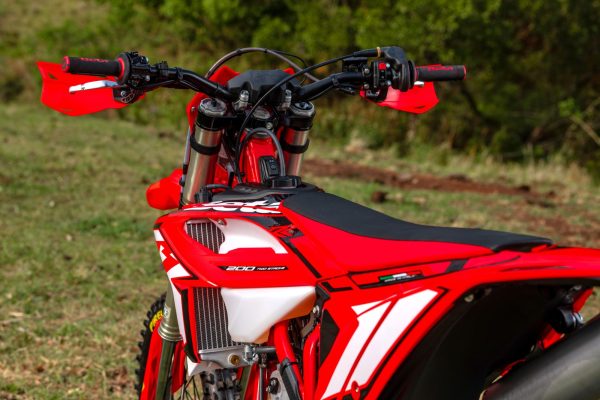
DOES IT HAVE A PLACE?
While so many manufacturers clearly don’t think the 200cc two-stroke has a place anywhere, Beta does and we’re stoked about that. It’s a unique capacity that Beta now owns so anyone in the 60-80kg mark that stands less than 180cm tall and is looking for a more serious bike than their current ride, the RR 200 is a fantastic machine. It will lug you up hills with ease thanks to its incredibly torquey engine (it’s nothing like 125cc power) and the suspension will perform perfectly for your size.
Add in the fact you don’t have to mix fuel thanks to the oil injection system, which we have never had issues with, and a host of other fancy accessories like the map switch and a powervalve for more or less abrupt power and the MY24 Beta RR 200 is a fantastic choice for any rider looking to step-up their off-road game.
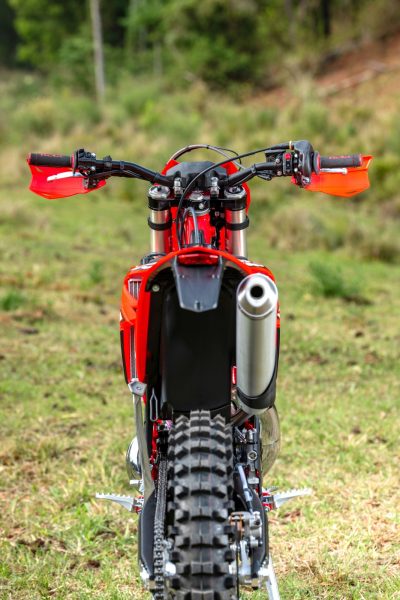
2024 BETA RR 200
ENGINE
TYPE Single-cylinder, two-stroke, liquid-cooled
BORE X STROKE 62mm x 63mm
DISCPLACEMENT 190.2cc
COMPRESSION RATIO 13.5:1
EXHAUST VALVE BPV system
STARTER Electric starter
FUELLING Keihin PWK 36
CLUTCH Wet multi-disc with reverse opening
TRANSMISSION Six-speed
FRAME Molybdenum steel with double cradle split above the exhaust post
DIMENSIONS
WHEEL BASE 1477mm
SEAT HEIGHT 930 mm
GROUND CLEARANCE 325 mm
WEIGHT 97.0kg (dry)
FUEL TANK 9.5L (2.3L reserve)
SUSPENSION
FRONT SUSPENSION 48mm ZF Hydraulic USD Fork, 295mm wheel travel
REAR SUSPENSION ZF Monoshock with progressive compound lever, 290mm wheel travel
BRAKES
FRONT BRAKE Nissin Wave disc 260mm, double-piston floating caliper
REAR BRAKE Nissin Wave disc ø240 mm, single-piston floating caliper
RUNNING GEAR
FRONT TYRE Pirelli Scorpion, 90/90 – 21
REAR TYRE Pirelli Scorpion, 140/80 – 18
PRICE & CONTACTS
RRP $15,095 Ride Away
WARRANTY 6 Months
BROWSER betamotor.com.au
